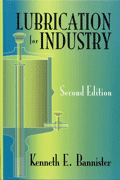Lubrication for Industry - Second Edition
|
|
Bonus Pack Included
with this item. |
- Vendor: Industrial Press
- Type: Book
Description
Written for maintenance managers and practitioners, Lubrication for Industry provides a fundamental understanding of how and why effective lubrication practices are an essential aspect of industrial equipment maintenance.
Focuses on the practical daily aspects of lubrication that impact productivity. Covers, in detail, failure analysis, costing techniques, modes of friction, generations of lubricants, oil and grease classifications and evaluations (including animal/vegetable, mineral, and synthetic), viscosity and other oil and grease standards and characteristics, lubricant compatibility guidelines, how to calculate bearing and other lubrication requirements, preventive maintenance including wear particle analysis, and filter rating and classifications.
Provides ten case studies drawn from the author's consulting experiences that emphasize the importance of developing and implementing effective, long-term solutions for lubrication, maintenance engineering, and maintenance management.
Author: Kenneth E. Bannister
Published: 2007
Format: Hardback
Pages: 166
Excerpt: CASE STUDY III - SYNTHETIC VERSUS MINERAL-BASED LUBRICANTS IN ADVERSE SITUATIONS PRODUCE SIGNIFICANT SAVINGS
"For the majority of situations, chemical wear first-generation lubricants perform adequately; for adverse conditions, such as extreme temperatures, the use of premium lubricants really pays off.
"A hydro utility study on energy reduction through lubrication engineering studied the use of synthetics in air compressors. The compressed air unit in the study was a 150-hp screw-type compressor that was recently rebuilt and utilized a standard 32 weight lube oil. A compressed air audit company gave the conveyor a clean bill of health. The power was monitored under varied load conditions and its power consumption noted. Because compressors run extremely hot, synthetic lubricants allow the press to run cooler, they also "desludge" or clean the compressor and allow it to run more efficiently, thereby reducing power consumption. Synthetics also allow for extended changeout intervals. The standard lubricant was replaced with a 32-weight fatty acid ester-type synthetic (second generation) lubricant. An energy reduction of 7.3% was gained by changing the lubricant, and the changeover also resulted in a cooler running compressor."
Table Of Contents:
Chapter 1-Maintaining for Profit
1.1 Cost of Maintenance
1.2 Reasons for Equipment Failure
1.3 Benefits of Good Lubrication
Review Questions
Chapter 2-Lubrication Theory
2.1 Tribologv
2.2 Defining Friction
2.3 Sliding Friction
2.4 Rolling Friction
2.5 Combination Friction (Sliding and Rolling)
2.6 Defining Lubrication
2.7 Basic Functions of a Lubricant
2.8 Lubrication Film
2.9 The Three Generations of Lubrication
Review Questions
Chapter 3-Oil and Grease
3.1 Oil Classifications
3.2 Oil-A Comparison Disadvantages
3.3 Viscosity
3.4 Viscosity Index
3.5 Oil Characteristics
3.6 Oil Standards
3.7 Oil Additives
3.8 Changeout of Brands or ~I~es of Oil
3.9 Grease~A Comparison of Advantages and Disadvantages
3.10 Grease Classification
3.11 Grease Characteristics
3.12 Grease Compatibility
3.13 Pumping Grease
3.14 How to Change Brands
Review Questions
Chapter 4-How Much and How Often?
4.1 Calculating Bearing Requirements
4.2 Basic Lubrication Requirement Calculation
4.3 Exceptions
Review Questions
Chapter 5-Selecting a Lubrication Delivery System
5.1 Oil or Grease?
5.2 Manual versus Automatic
5.3 Delivery Systems
5.4 Basic Selection Procedure for Lubrication System Design
Review Questions
Chapter 6-Preventivelpredictive Maintenance
6.1 Preventive Maintenance
6.2 Lube Routes/Color Routes
6.3 Wear Particle Analysis-Predicting Lubricant Failure
Review Questions
Chapter 7-Health, Safety, Storage, and Handling
7.1 Health and Safety
7.2 Lubricant Storage Containers
7.3 Storage Dos and Don'ts
7.4 Handling and Disposal Dos and Don'ts
Review Questions
Chapter 8-Filtration
8.1 Filter Classifications
8.2 Filter Ratings
Review Questions
Glossary of Terms
ASTM Routine Tests for Lubricants
Appendix of Commonly Used Conversion Factors
Bibliography




